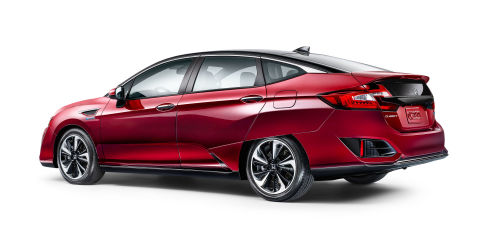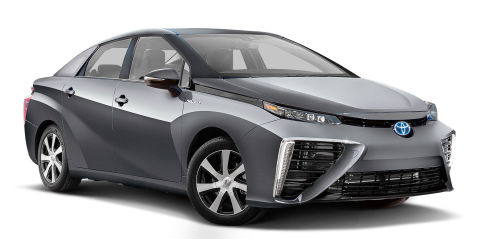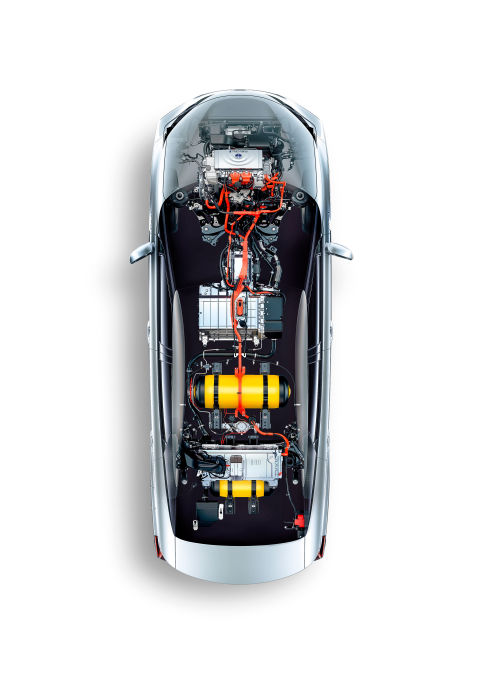Wyatt earp
Diamond Member
- Apr 21, 2012
- 69,975
- 16,383
- 2,180
I never knew Obama killed funding for hydrogen R&D and instead of funded ancient 180 year old electric battery cars..why did he do that? Follow the money I guess another Bell vs telsa game...A/C vs D/C
Meanwhile the Japanese is taking over ..
http://www.popularmechanics.com/car...867/hydrogen-cars-toyota-murai-honda-clarity/
Meet the Next Generation of the Hydrogen Car
Driving Toyota's and Honda's next-gen fuel-cells.
A simple chemical reaction between hydrogen and oxygen generates energy, which can be used to power a car, producing only water, not exhaust fumes." That was George W. Bush in 2003, proposing $1.2 billion to research fuel-cell automobiles. Six years later, President Obama killed that funding
Meanwhile, over in Japan, Toyota and Honda have been at work, spending millions in R&D to make the new hydrogen-powered Mirai and Clarity. It's more reasonable than it sounds. Fuel-cell cars are as appealing now as they were during Bush's first term. It's still the only way to get zero-emissions driving with gasoline convenience—pull up to the pump, wait five minutes, and be on your way. But with less than 40 public hydrogen pumps in the United States, the only Mirai and Clarity customers will be coastal and in big cities. At least for now. We drove the Mirai in Los Angeles and the Clarity in New York, two places promising to build more hydrogen stations in the next two years, to assess both cars' present-day drivability.
HONDA CLARITY

Honda
The sensible crossover-hatchback roofline, the upright driving posture, seating for five adults. It all makes you think: Your Uber is now arriving. Yes, a driver could press the Clarity's Sport mode button and have fun with the on ramps. The steering and especially the brakes feel as natural as any of Honda's excellent OPEC-powered models. But at 4,000-plus pounds and with a zero-to-60 we'd estimate near double digits, you don't get gasoline thrills.
The Clarity comes in one trim option that's loaded with tech like lane-departure warning and automatic braking. Wrapped in suede made from recycled plastic, the digital dash has a ball that shrinks and expands, coaching you toward efficient driving. As long as performance isn't a priority, all that adds up to a hell of a lot of civility for the price, which is a loss-leader low. You can't buy a Clarity—Honda says MSRP would hit near $60,000. You lease it for about $3,000 down and $369 a month. Along with the car, Honda gives you a $15,000 credit card to spend on hydrogen fill-ups. And 21 days of petroleum-car rentals for longer trips. And Californians get a $5,000 rebate. And an HOV sticker. Pick up a few weekend driving shifts and going fuel-cell is cheaper than an iPhone upgrade.—Alexander George
Base price: $369 per month (lease only)
Range: 366 miles
The rear hydrogen tanks are covered in carbon fiber and aluminum to protect against punctures.
TOYOTA MIRAI

Toyota Murai
Driving north out of Los Angeles, I notice the battery gauge tick down a few bars and experience the familiar twinge of range anxiety. Then, the battery display pulls a stunt I've never seen in an electric car, climbing back up to near full. The car charged itself. So cool.
What really happened is that the Mirai's fuel cells sent over some electricity to top off the nickel-metal-hydride battery that powers the 153-hp drive motor. Range concerns alleviated, I gun the little Toyota toward an off ramp, its fuel cells ramping up with a sound that's like someone mowing a lawn two blocks over. Acceleration is reminiscent of a small diesel with excellent torque, good fun once you know how to use it. But the Mirai is a modest setup. Toyota is already demonstrating the high-power possibilities with a heavy-duty truck. The twin fuel cells in that sucker make 670 horsepower and 1,325 lb-ft of torque. Imagine that in a Camry.

The fuel cell is under the hood, and the 245-volt battery sits beneath the seats, for a low center of gravity.
A few dozen miles later, I look in the rearview mirror to see . . . another Mirai. Is that a glimpse into the future? Fuel cells obviously work. But the question is the same now as it was a decade ago, before the EV takeover—whether something just over the horizon might work even better.—Ezra Dyer
Base price: $57,500
Range: 312 miles
.
Meanwhile the Japanese is taking over ..
http://www.popularmechanics.com/car...867/hydrogen-cars-toyota-murai-honda-clarity/
Meet the Next Generation of the Hydrogen Car
Driving Toyota's and Honda's next-gen fuel-cells.
A simple chemical reaction between hydrogen and oxygen generates energy, which can be used to power a car, producing only water, not exhaust fumes." That was George W. Bush in 2003, proposing $1.2 billion to research fuel-cell automobiles. Six years later, President Obama killed that funding
Meanwhile, over in Japan, Toyota and Honda have been at work, spending millions in R&D to make the new hydrogen-powered Mirai and Clarity. It's more reasonable than it sounds. Fuel-cell cars are as appealing now as they were during Bush's first term. It's still the only way to get zero-emissions driving with gasoline convenience—pull up to the pump, wait five minutes, and be on your way. But with less than 40 public hydrogen pumps in the United States, the only Mirai and Clarity customers will be coastal and in big cities. At least for now. We drove the Mirai in Los Angeles and the Clarity in New York, two places promising to build more hydrogen stations in the next two years, to assess both cars' present-day drivability.
HONDA CLARITY

Honda
The sensible crossover-hatchback roofline, the upright driving posture, seating for five adults. It all makes you think: Your Uber is now arriving. Yes, a driver could press the Clarity's Sport mode button and have fun with the on ramps. The steering and especially the brakes feel as natural as any of Honda's excellent OPEC-powered models. But at 4,000-plus pounds and with a zero-to-60 we'd estimate near double digits, you don't get gasoline thrills.
The Clarity comes in one trim option that's loaded with tech like lane-departure warning and automatic braking. Wrapped in suede made from recycled plastic, the digital dash has a ball that shrinks and expands, coaching you toward efficient driving. As long as performance isn't a priority, all that adds up to a hell of a lot of civility for the price, which is a loss-leader low. You can't buy a Clarity—Honda says MSRP would hit near $60,000. You lease it for about $3,000 down and $369 a month. Along with the car, Honda gives you a $15,000 credit card to spend on hydrogen fill-ups. And 21 days of petroleum-car rentals for longer trips. And Californians get a $5,000 rebate. And an HOV sticker. Pick up a few weekend driving shifts and going fuel-cell is cheaper than an iPhone upgrade.—Alexander George
Base price: $369 per month (lease only)
Range: 366 miles
The rear hydrogen tanks are covered in carbon fiber and aluminum to protect against punctures.
TOYOTA MIRAI

Toyota Murai
Driving north out of Los Angeles, I notice the battery gauge tick down a few bars and experience the familiar twinge of range anxiety. Then, the battery display pulls a stunt I've never seen in an electric car, climbing back up to near full. The car charged itself. So cool.
What really happened is that the Mirai's fuel cells sent over some electricity to top off the nickel-metal-hydride battery that powers the 153-hp drive motor. Range concerns alleviated, I gun the little Toyota toward an off ramp, its fuel cells ramping up with a sound that's like someone mowing a lawn two blocks over. Acceleration is reminiscent of a small diesel with excellent torque, good fun once you know how to use it. But the Mirai is a modest setup. Toyota is already demonstrating the high-power possibilities with a heavy-duty truck. The twin fuel cells in that sucker make 670 horsepower and 1,325 lb-ft of torque. Imagine that in a Camry.

The fuel cell is under the hood, and the 245-volt battery sits beneath the seats, for a low center of gravity.
A few dozen miles later, I look in the rearview mirror to see . . . another Mirai. Is that a glimpse into the future? Fuel cells obviously work. But the question is the same now as it was a decade ago, before the EV takeover—whether something just over the horizon might work even better.—Ezra Dyer
Base price: $57,500
Range: 312 miles
.
Attachments
Last edited:



